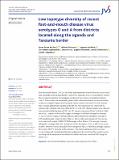| dc.contributor.author | Kerfua, Susan Diana | |
| dc.contributor.author | Kusiluka, Lughano | |
| dc.contributor.author | Ayebazibwe, Chrisostome | |
| dc.contributor.author | Martin, Esau | |
| dc.contributor.author | Arinaitwe, Eugene | |
| dc.contributor.author | Cleaveland, Sarah | |
| dc.contributor.author | Haydon, Daniel | |
| dc.contributor.author | Shirima, Gabriel | |
| dc.date.accessioned | 2020-03-27T08:07:19Z | |
| dc.date.available | 2020-03-27T08:07:19Z | |
| dc.date.issued | 2019-03-01 | |
| dc.identifier.uri | https://doi.org/10.4142/jvs.2019.20.e4 | |
| dc.identifier.uri | https://dspace.nm-aist.ac.tz/handle/20.500.12479/673 | |
| dc.description | This research article published by The Korean Society of Veterinary Science, 2019 | en_US |
| dc.description.abstract | Foot-and-mouth disease (FMD) is one of the most important livestock diseases in East Africa with outbreaks reported annually that cause severe economic losses. It is possible to control disease using vaccination, but antigenic matching of the vaccine to circulating strains is critical. To determine the relationship between foot-and-mouth disease viruses circulating in districts along the Uganda and Tanzanian border between 2016 and 2017 and currently used vaccines, phylogenetic analysis of the full VP1 virus sequences was carried out on samples collected from both sides of the border. A total of 43 clinical samples were collected from animals exhibiting signs of FMD and VP1 sequences generated from 11 of them. Eight out of the 11 sequences obtained belonged to serotype O and three belonged to serotype A. The serotype O sequences obtained showed limited nucleotide divergence (average of 4.9%) and belonged to topotype East Africa-2, whereas the most common O-type vaccine strain used in the region (O/KEN/77/78) belonged to East Africa-1. The serotype A viruses belonged to topotype Africa-G1 (average nucleotide divergence 7.4%), as did vaccine strain K5/1980. However, vaccine strain K35/1980 belonged to Africa G VII with an average sequence divergence of 20.5% from the study sequences. The genetic distances between current vaccine strains and circulating field strains underscores the crucial need for regular vaccine matching and the importance of collaborative efforts for better control of FMD along this border area. | en_US |
| dc.description.sponsorship | sequences
topotype
virus | en_US |
| dc.language.iso | en | en_US |
| dc.publisher | The Korean Society of Veterinary Science | en_US |
| dc.subject | Foot-and-mouth disease | en_US |
| dc.title | Low topotype diversity of recent foot-and-mouth disease virus serotypes O and A from districts located along the Uganda and Tanzania border. | en_US |
| dc.type | Article | en_US |

